
Wine Culture and Information since 2002 - Volume 22
 Wine Culture and Information since 2002 - Volume 22 |
|
Issue 130, June 2014 |
Contents |
|
|
Make It Simple |
|
It is now quite a long of time, in the world of wine, they are saying we should simplify the way we are communicating the subject about the beverage of Bacchus. It seems wine is a quite hard subject, difficult and incomprehensible, what the people read or listen about wine leave them confused and distant. Wine is a popular beverage belonging to everyone's culture, despite in remote times it was mainly used for sacred purposes and, most of the times, exclusively consumed by the officiants of religious rites. The original sacred role of wine changed over time and it quickly became the protagonist of banquets and symposia, most of the times being far away from the common concept of sacredness, considered as a beverage capable of cheering up life and pleasure of men. Therefore considered as a “food”, wine quickly played an important role in social and popular life, an element of strong cultural and traditional meaning. In the course of its history, wine has always been subject of comparisons, virtually endless debates on what was the best, on the best grapes, areas, producers and styles. By considering the literature of the past, wine has frequently been subject of books and it has been mentioned in many documents as well as being subject of many paintings and works. It is simply the sign of the importance wine has for men, from simple fellow of the table to symbol of richness and wellness, last but not the least, a sign of social identification. Personal assets, today and in the past, allow in fact to enjoy the best wines: in the tables of the affluent classes quality wines has always been found. The ones who could not afford it - today and in the past - always had to be happy with what their assets allowed them to buy, and they also had to find a way to like it. Around wine has been created a specific vocabulary that, more or less, everyone uses in order to tell wine qualities. It is not, of course, a forced model everyone must use, indeed it is a method allowing the sharing of technical concepts. The result of these conventions undoubtedly had the merit of encouraging wine making quality, by communicating - not only to technicians, but also to consumers - the criteria of a reference quality. It should however be noticed quality is never an absolute factor: it is a reference model in which a group recognizes a model as well as the same moral and cultural principles. This is also true for consumers and producers as, it is undeniable, the concept of wine quality is not always agreed in different groups. There are factors, like to say, universally accepted to which are added the ones of each group. If it is true the quality of wine got better in the last years, this undeniably was because of this type of communication which forced, like to say, producers to make better wines. This also caused the promotion of wine culture in consumers, who had tools and information allowing them a better understanding of wine quality. Sometimes they exaggerated in this, sometimes the concepts have been exasperated while making them vague and incomprehensible, however it is also true this avoided wine to become a banal subject. A complex beverage, result of many factors, each of them equally important in making the character of wine, they cannot be considered superficially. Superficiality is, after all, one of the typical factors of standardization: everything looks the same, everything must sadly be the same. I frequently hear producers and communicators, also the ones belonging to certain wine associations, saying communication of wine should be simpler. I do not completely agree on this, although I agree on the fact the excess of technique is something mainly interesting for the ones working in the world of wine while it is negligible for consumers. After all, it is easily understandable consumers can be puzzled by an excessive technical talk typical of wine makers and tasters. Wine, after all, is a popular beverage and who consume wine is not usually interested in making it: they are mainly interested in its appreciation. Producers, besides making wine, have the need to sell it, even in case it is not exactly good or does not necessarily meet universally agreed quality criteria. On this regard, it certainly is easier to sell mediocre products to consumers having a “simple and simplified” culture. For this reason, in particular in these times - which cannot be certainly defined favorable according to an economy point of view - I believe producers strongly need to make profits “at any cost”. Demanding consumers want - according to their assets - products of higher quality. Ignorant consumers, plagiarized by a simple culture and with no pretensions, can be easily directed towards standardization. It is very easy, at that point, to make someone believe a mediocre or a bad product is of very high quality, in particular to those having a simple view. In case we simply consider a speculative point of view of the ones making wine and want to get the best profit out of it, the most important thing is selling wine, it is important consumers uncork and drink bottles. The rest is marginal and can also be an obstacle to this goal. For many years we focused on the differences and the importance of every single factor - including territory, grapes, producers - and the simplification of these concepts make them appear banal, even secondary and useless. Knowledge makes a difference, this is true in everything, including wine. Let's then welcome a wine told in simple ways, hopefully with the same banal and frivolous tales of magic and enchanted worlds: after all, all we need to know about a wine is whether it is red or white. Simple, clear, everyone can understand that, in particular, when they are not talking about wine at all. The rest is useless, complicated and boring. Antonello Biancalana
|
||||
Improving Your Tasting SkillsBeing successful in sensorial tasting of wine is the result of a continuous will of improving our skills. |
|
Sensorial tasting of wine is a practice capable of giving emotions and satisfaction, something certainly renewing at each bottle and at each glass. Moreover, it is a practice requiring commitment, concentration and attention as sometimes the taster can also need to evaluate difficult wines and not easily understandable. Each wine, with no exception, offers a chance to improve our tasting skills. This is also true for the wines tasted in the past as, although this can be seen as exaggerated, each bottle of the same wine is different from all the other ones. For this reason, sensorial tasting of wine done with a critical and analytical goal cannot be done superficially. In particular, every time a wine is being tasted - including in informal occasions - it should be considered as a moment giving an opportunity of study. On this regard, it should be noticed sensorial tasting done informally and in places capable of influencing the perception of wine, should be considered in function of the conditions. The presence of non properly favorable conditions however allows the understanding of how certain elements are capable of affecting and influencing the perception of a wine. Therefore, the tasting done in not truly favorable conditions, however offers the tasters an opportunity of study and improvement according to the influence of certain factors. Unfortunately, in these cases the elements of study offered by a wine are limited in function of conditioning factors and it will be the skill of the taster to allow him or her to get the most out of the circumstance. In these specific conditions it will however be possible to get some general and useful elements for the evaluation of wine, properly filtered from disturbing factors. The skill of taking advance of every occasion in which a wine is being tasted is, as a matter of fact, an important factor allowing the improvement of our skills. In fact, it is fundamental to continuously practice the task of tasting. The analogy with an athlete is clearly appropriate: in order to get better results he or she needs a continuous training, with commitment and method. After all, we cannot expect to learn the practice of sensorial tasting by simply reading books, magazine reports or wine reviews. Practice is fundamental. What we read in books and magazines is however useful for learning the theory and for comparing our own evaluations. Learning wine making techniques and viticulture is fundamental in order to improve our tasting skills. We cannot, in fact, analyze and evaluate a wine in case we do not know how it is made, from vineyard to bottle. The study of viticulture and enology in fact allows the understanding of how the many techniques can influence the sensorial qualities of wine. Of course, we do not need to have deep knowledge on these subjects, something being essential for the ones cultivating a vineyard or making wine. The study of viticulture and enology cannot however be superficial or elementary: the advantage of knowing how certain results can be obtained in vineyard and in winery, and how they interact in function of a wine, gives the taster a better understanding of what has been poured in a glass.
Knowing how a wine is made also gives an undeniable advantage for the understanding of one of the most cunning aspects of sensorial evaluation: faults. Being capable of recognizing wine faults certainly is one of the most complex aspects and for which a taster usually does not pay much attention during the study. Recognizing faults and knowing the factors causing them, represent for the taster a superior advantage and skill. Not being capable of doing so, the perception of a smell of which one is not capable of classifying or identifying, leaves the taster in a complete uncertainty and this can also affect the final result. Moreover, not being capable of recognizing faults can also make the taster classify an obvious fault as a good quality, by identifying it as a typical and positive characteristic of a wine. For this reason, a taster should pay attention on the study and the recognition of wine faults. Like already said in other occasions, a quality wine is - first of all - a wine having the least possible number of faults. In case an evident fault is perceived in a wine - and in case we are not tasting a series of wines - it is good to concentrate on its study instead of rejecting that wine. The same should not be done in case we are tasting a series of wines, as a wine with an evident olfactory or gustatory fault could affect the perception and the evaluation of the next ones. The circumstance is negligible in case of faults in the appearance of wine. In case we cannot explain the causes of a fault because our wine making and viticulture knowledge does not allow us to do so, it is advised - in case we can do that - to ask an expert taster or wine maker, in order to get another chance of study. To recognize means, first of all, to know. You cannot, in fact, identify something - both in positive or negative terms - if you don't know it. Besides the useful predisposition for curiosity - every sensorial stimulus is an important chance of study for every taster - we also need a very good sensorial memory. This skill is particularly useful for the identification of aromas, among the main aspects of sensorial evaluation in a wine. The use of analogy for olfactory descriptors is a very common practice during the tasting of a wine. It is in fact a useful simplification in order to easily communicate and olfactory stimulus to everyone. Saying in a wine is being perceived the aroma of black pepper is something understandable to everyone and can be easily associated. Saying it is being perceived rotundone - the sesquiterpene responsible for the aromas of black pepper, found in certain wines produced with Syrah grape - is probably incomprehensible to many. Having a sensorial curiosity, that is to pay attention to sight, smell, taste and touch stimuli, is a practice every taster should do all the time, in particular in case of the perception of new and unknown stimuli. Likewise, the perception of a known stimulus makes both a useful memory training and a chance to perfect and widen the information associated to that stimulus. Let's consider, for example, the smell of apple. If it is true the base mark allows the immediate association to this fruit, it is also true not all the apples have the same smell and, moreover, it can also change according to ripeness and keeping. A green apple has a different smell from a russet apple, both different from the aromas of a Fuji apple. Another good habit every taster should have, certainly useful for the improvement of his or her skills, is to take note of the tasting. For this purpose can be used the evaluation forms used by professional wine associations or we can also create a personal model based on criteria and methods useful for the proper sensorial description of a wine. In case the taster prefer not to use evaluation forms, another good way is to take note in a notebook in the form and way the taster like the best. Tasting notes help the taster to “remember” his or her impressions, while allowing the creation of a personal database about this activity. This “database” is very useful in order to remember sensorial qualities of wines also in function of the territory, grapes, vintages and wine making techniques. It is advised to classify and catalog tasting notes or evaluation forms in order to allow a quicker and better browsing and search. On this regard, a computer certainly is very useful, as well as a tablet or smartphone, in particular in searching data, while allowing a quick extraction of information and their comparison. In case it is not possible to create a specific software for this purpose, it can also be used any database software, or a simple word processor, by properly classifying the single forms and notes. In this sense, the use of the computer is very useful in order to search and compare wines having particular characteristics, therefore having a good tool for studying and for training your memory. The method adopted for sensorial tasting is essential in order to improve the taster's skills. Concentration and attention are fundamental requisites in order to ensure a reliable result of the evaluation, conditions mainly favored by blind tasting. This is in fact the preferred method used for the taster education and training, as the lack of identifying elements and factors will force the taster to a higher concentration and attention. The so called unblind tasting - unavoidable in certain cases - however offers chances of study, although some aspects of the wine will be considered as predictable and obvious, therefore considered superficially. No matter the case, it is always advised to get the best profit out of the tasting condition, no matter the goal and method. Finally, one of the fundamental factors allowing the taster to efficiently do its job certainly is represented by experience. A condition taking time and commitment, in particular the awareness that you will always be learning as every wine is different from any other one and, as such, it cannot be considered superficially. In every wine will certainly be found known characteristics and learned from previous tastings, we can recognize grape varieties and specific wine making techniques, however it will always have a personality different from every other wine. Improving our sensorial tasting skills takes time, patience and commitment, in particular the awareness that - in order to get good results - it is fundamental to persevere both in training and practice.
|
||||||||||||
Wines of the Month |
|
|
|
Score legend Prices are to be considered as indicative. Prices may vary according to the country or the shop where wines are bought |
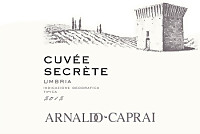
|
|
Cuvée Secrète 2012 |
|
| Arnaldo Caprai (Umbria, Italy) | |
| Grapes: n.d. | |
| Price: € 30.00 | Score: |
| Cuvée Secrète shows a brilliant straw yellow color and nuances of straw yellow, very transparent. The nose reveals intense, clean, pleasing and refined aromas which start with hints of apple, banana and pear followed by aromas of plum, peach, citrus fruits, vanilla, acacia honey, broom, hazelnut and mineral. The mouth has good correspondence to the nose, a crisp attack and however balanced by alcohol, good body, intense flavors, pleasing roundness. The finish is persistent with flavors of banana, apple and pear. Cuvée Secrète ages for 6 months in barrique followed by 4 months of aging in bottle. | |
| Food Match: Pasta with meat, Roasted white meat, Roasted fish, Legume soups | |
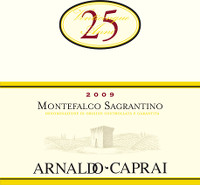
|
|
Montefalco Sagrantino 25 Anni 2009 |
|
| Arnaldo Caprai (Umbria, Italy) | |
| Grapes: Sagrantino | |
| Price: € 55.00 | Score: |
| Montefalco Sagrantino 25 Anni shows a deep ruby red color and nuances of ruby red, little transparency. The nose reveals intense, clean, pleasing, refined and elegant aromas which start with hints of blackberry, plum and black cherry followed by aromas of violet, blueberry, vanilla, tobacco, chocolate, peony, cinnamon, mace, pink pepper, licorice and menthol. The mouth has excellent correspondence to the nose, a tannic attack and however balanced by alcohol, full body, intense flavors, agreeable. The finish is very persistent with long flavors of blackberry, black cherry and plum. Montefalco Sagrantino 25 Anni ages for 24 months in barrique followed by at least 8 months of aging in bottle. | |
| Food Match: Game, Roasted meat, Stewed and braised meat, Hard cheese | |
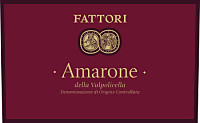
|
|
Amarone della Valpolicella 2009 |
|
| Fattori (Veneto, Italy) | |
| Grapes: Corvina (65%), Corvinone (15%), Rondinella (10%), Other Grapes (10%) | |
| Price: € 50.00 | Score: |
| This Amarone della Valpolicella shows a deep ruby red color and nuances of garnet red, little transparency. The nose denotes intense, clean, pleasing, refined and elegant aromas that start with hints of black cherry, plum and blackberry followed by aromas of dried violet, blueberry, vanilla, chocolate, tobacco, cinnamon, mace and menthol. The mouth has good correspondence to the nose, a tannic attack and however balanced by alcohol, full body, intense flavors, pleasing roundness. The finish is persistent with flavors of black cherry, blackberry and plum. This Amarone della Valpolicella ages for 36 months in cask. | |
| Food Match: Game, Braised and stewed meat, Roasted meat, Hard cheese | |
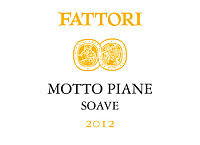
|
|
Soave Motto Piane 2012 |
|
| Fattori (Veneto, Italy) | |
| Grapes: Garganega | |
| Price: € 22.00 | Score: |
| Soave Motto Piane shows an intense golden yellow color and nuances of golden yellow, very transparent. The nose reveals intense, clean, pleasing, refined and elegant aromas which start with hints of apple, plum and almond followed by aromas of medlar, peach, citrus fruits, hawthorn, honey, plum, pear and hints of vanilla. The mouth has good correspondence to the nose, a crisp attack and however balanced by alcohol, good body, intense flavors, pleasing roundness. The finish is persistent with flavors of apple, plum and medlar. Soave Motto Piane is produced with partially dried grapes and part of it ages in cask. | |
| Food Match: Pasta and risotto with vegetable and crustaceans, Mushroom soups, Roasted white meat, Roasted fish | |

|
|
Le Margherite 2010 |
|
| Mossio (Piedmont, Italy) | |
| Grapes: Dolcetto | |
| Price: € 22.00 - 500ml | Score: |
| Le Margherite shows a deep ruby red color and nuances of garnet red, little transparency. The nose denotes intense, clean, pleasing and refined aromas which start with hints of cherry jam, prune and dried violet followed by aromas of blackberry jam, strawberry jam, blueberry jam, raspberry jam, vanilla and nail polish. The mouth has good correspondence to the nose, a sweet and properly tannic attack, however balanced by alcohol, good body, intense flavors, pleasing roundness. The finish is persistent with flavors of cherry jam, prune and blueberry jam. Le Margherite is made with dried grapes and ages for 24 months in barrique. | |
| Food Match: Jam tarts, Hard cheese | |
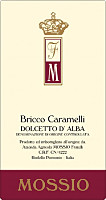
|
|
Dolcetto d'Alba Bricco Caramelli 2012 |
|
| Mossio (Piedmont, Italy) | |
| Grapes: Dolcetto | |
| Price: € 11.00 | Score: |
| Dolcetto d'Alba Bricco Caramelli shows an intense ruby red color and nuances of purple red, little transparency. The nose reveals intense, clean, pleasing, refined and elegant aromas which start with hints of cherry, blackberry and plum followed by aromas of raspberry, strawberry, violet, blueberry, almond, anise, cyclamen, geranium and mint. The mouth has excellent correspondence to the nose, a properly tannic attack and however balanced by alcohol, good body, intense flavors, pleasing crispness and roundness. The finish is very persistent with long flavors of cherry, plum and blackberry. Dolcetto d'Alba Bricco Caramelli ages in steel tanks. | |
| Food Match: Cold cuts, Pasta with meat and mushrooms, Roasted white meat, Sauteed meat | |
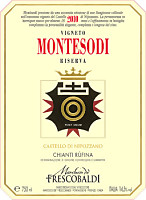
|
|
Chianti Rufina Riserva Montesodi Castello di Nipozzano 2010 |
|
| Marchesi de' Frescobaldi (Tuscany, Italy) | |
| Grapes: Sangiovese | |
| Price: € 35.00 | Score: |
| Chianti Rufina Riserva Montesodi Castello di Nipozzano shows a brilliant ruby red color and nuances of garnet red, moderate transparency. The nose denotes intense, clean, pleasing, refined and elegant which start with hints of black cherry, plum and dried violet followed by aromas of raspberry, blueberry, chocolate, vanilla, tobacco, pink pepper, mace and menthol. The mouth has good correspondence to the nose, a tannic attack and however balanced by alcohol, full body, intense flavors, pleasing crispness. The finish is persistent with flavors of black cherry, plum and raspberry. Chianti Rufina Riserva Montesodi Castello di Nipozzano ages for 18 months in barrique followed by 6 months of aging in bottle. | |
| Food Match: Game, Roasted meat, Stewed and braoised meat, Hard cheese | |
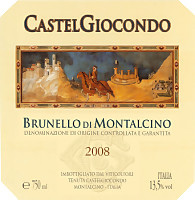
|
|
Brunello di Montalcino Castelgiocondo 2008 |
|
| Marchesi de' Frescobaldi (Tuscany, Italy) | |
| Grapes: Sangiovese | |
| Price: € 40.00 | Score: |
| Brunello di Montalcino Castelgiocondo shows a brilliant ruby red color and nuances of garnet red, little transparency. The nose denotes intense, clean, pleasing, refined and elegant aromas which start with hints of black cherry, plum and violet followed by aromas of blueberry, vanilla, blackberry, rose, tobacco, chocolate, raspberry, cinnamon, mace and menthol. The mouth has good correspondence to the nose, a tannic attack and however balanced by alcohol, full body, intense flavors, agreeable. The finish is persistent with flavors of black cherry, plum and blueberry. Brunello di Montalcino Castelgiocondo ages in cask and barrique for at least 2 years followed by at least 4 months of aging in bottle. | |
| Food Match: Game, Roasted meat, Braised and stewed meat, Hard cheese | |
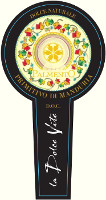
|
|
Primitivo di Manduria Dolce Naturale La Dolce Vite 2009 |
|
| L'Antico Palmento (Apulia, Italy) | |
| Grapes: Primitivo | |
| Price: € 28.00 | Score: |
| Primitivo di Manduria Dolce Naturale La Dolce Vite shows a deep ruby red color and nuances of garnet red, little transparency. The nose denotes intense, clean, pleasing and refined aromas which start with hints of plum jam, blackberry jam, black cherry jam and dried violet followed by aromas of blueberry jam, tamarind, walnut husk, carob and nail polish. The mouth has good correspondence to the nose, a sweet and tannic attack, however balanced by alcohol, full body, intense flavors, pleasing roundness. The finish is persistent with flavors of blackberry jam, black cherry jam and plum jam. Primitivo di Manduria Dolce Naturale La Dolce Vite ages in steel tanks. | |
| Food Match: Jam tarts, Chocolate tarts, Hard and piquant cheese | |
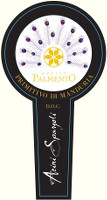
|
|
Primitivo di Manduria Acini Spargoli 2011 |
|
| L'Antico Palmento (Apulia, Italy) | |
| Grapes: Primitivo | |
| Price: € 24.00 | Score: |
| Primitivo di Manduria Acini Spargoli shows an intense ruby red color and nuances of ruby red, little transparency. The nose denotes intense, clean, pleasing, refined and elegant aromas which start with hints of blackberry, black cherry and plum followed by aromas of violet, blueberry, vanilla, walnut husk, chocolate, tobacco and menthol. The mouth has good correspondence to the nose, a tannic attack and however balanced by alcohol, full body, intense flavors, pleasing roundness. The finish is persistent with flavors of blackberry, black cherry and plum. Primitivo di Manduria Acini Spargoli ferments in barrique, ages in steel tanks and for 6 months in bottle. | |
| Food Match: Roasted meat, Game, Braised and stewed meat, Hard cheese | |
News |
|
In this section are published news and information about events concerning the world of wine and food. Whoever is interested in publishing this kind of information can send us a mail to our address.
|
AquavitaeReview of Grappa, Distillates and Brandy |
|
|
| Distillates are rated according to DiWineTaste's evaluation method. Please see score legend in the "Wines of the Month" section. |
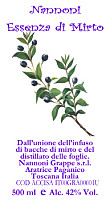
|
|
Essenza di Mirto |
|
| Nannoni (Tuscany, Italy) | |
| Raw matter: Alcohol, Myrtle berries, Distillate of myrtle leaves | |
| Price: € 25.00 - 50cl | Score: |
| Essenza di Mirto shows a brilliant coppery color, limpid and crystalline. The nose reveals intense, clean, pleasing and refined aromas of myrtle berries and leaves, honey, with almost imperceptible alcohol pungency. In the mouth has intense flavors with perceptible alcohol pungency which tends to dissolve rapidly, good correspondence to the nose, pleasing roundness, balanced sweetness. The finish is persistent with flavors of myrtle. Essenza di Mirto is produced by infusing myrtle berries in wine alcohol to which it is added a distillate of myrtle leaves. | |
Wine Parade |
|
|
| The best 15 wines according to DiWineTaste's readers. To express your best three wines send us an E-mail or fill in the form available at our WEB site. |
| Rank | Wine, Producer | |
|---|---|---|
| 1 |
| Amarone della Valpolicella Classico Capitel Monte Olmi 2007, Tedeschi |
| 2 |
| Villa Gresti 2006, Tenuta San Leonardo |
| 3 |
| Langhe Riesling Herzu 2011, Ettore Germano |
| 4 |
| Brunello di Montalcino 2007, Donatella Cinelli Colombini |
| 5 |
| Brunello di Montalcino Vigna Loreto 2007, Mastrojanni |
| 8 |
| Sagrantino di Montefalco Collepiano 2007, Arnaldo Caprai |
| 7 |
| Verdicchio dei Castelli di Jesi Classico Superiore Podium 2010, Garofoli |
| 8 |
| Pelago 2009, Umani Ronchi |
| 9 |
| Camartina 2008, Querciabella |
| 10 |
| Maximo 2010, Umani Ronchi |
| 11 |
| San Leonardo 2006, Tenuta San Leonardo |
| 12 |
| Collio Ribolla Gialla L'Adelchi 2012, Venica |
| 13 |
| I Sodi di San Niccolò 2008, Castellare di Castellina |
| 14 |
| Trento Brut Riserva Methius 2006, Dorigati |
| 15 |
| Adarmando 2011, Tabarrini |
| |||||||
Privacy Policy | |||||||


| Copyright © 2002-2024 Antonello Biancalana, DiWineTaste - All rights reserved |
| All rights reserved under international copyright conventions. No part of this publication and of this WEB site may be
reproduced or utilized in any form or by any means, electronic or mechanical, without permission in writing from DiWineTaste. |